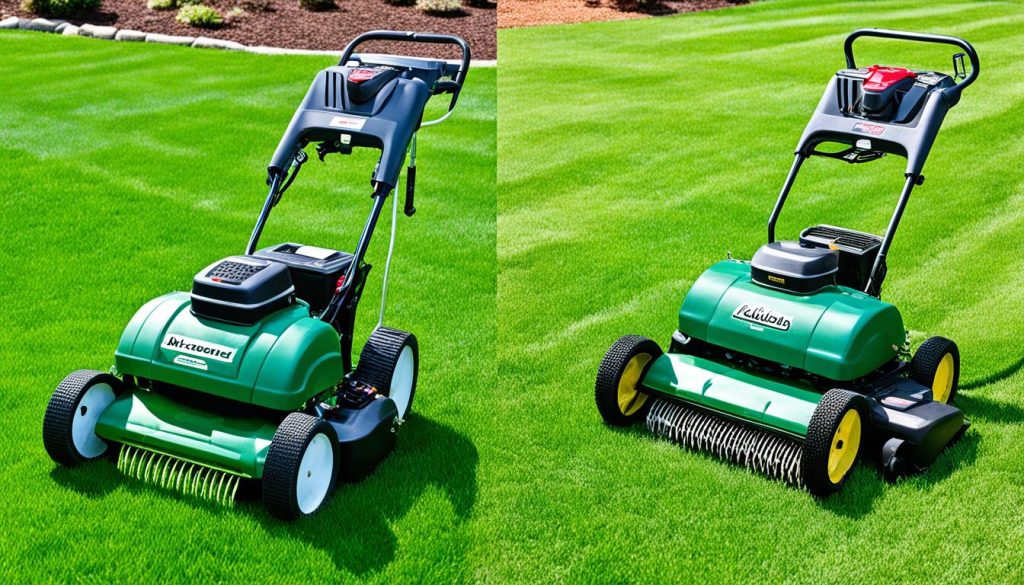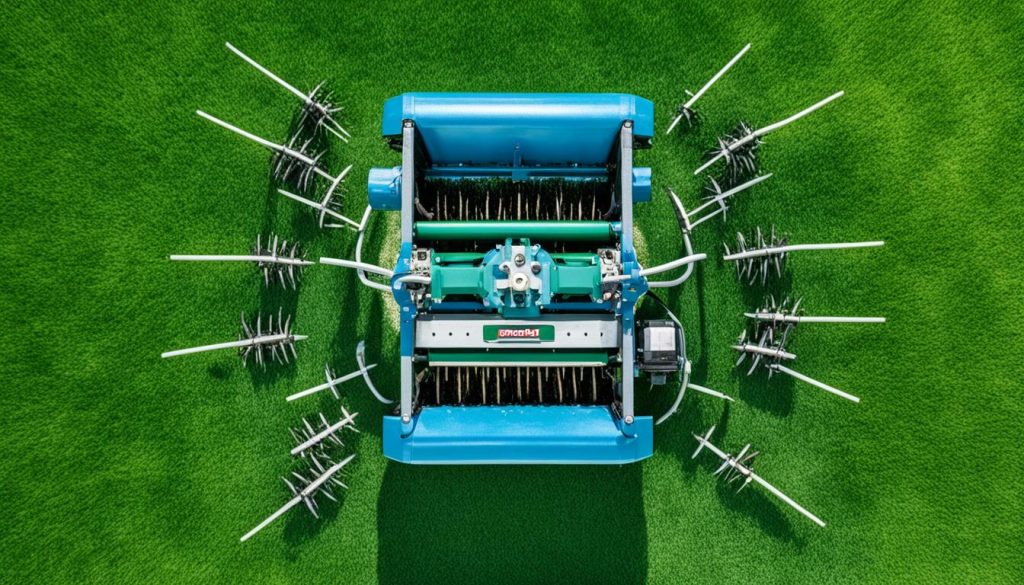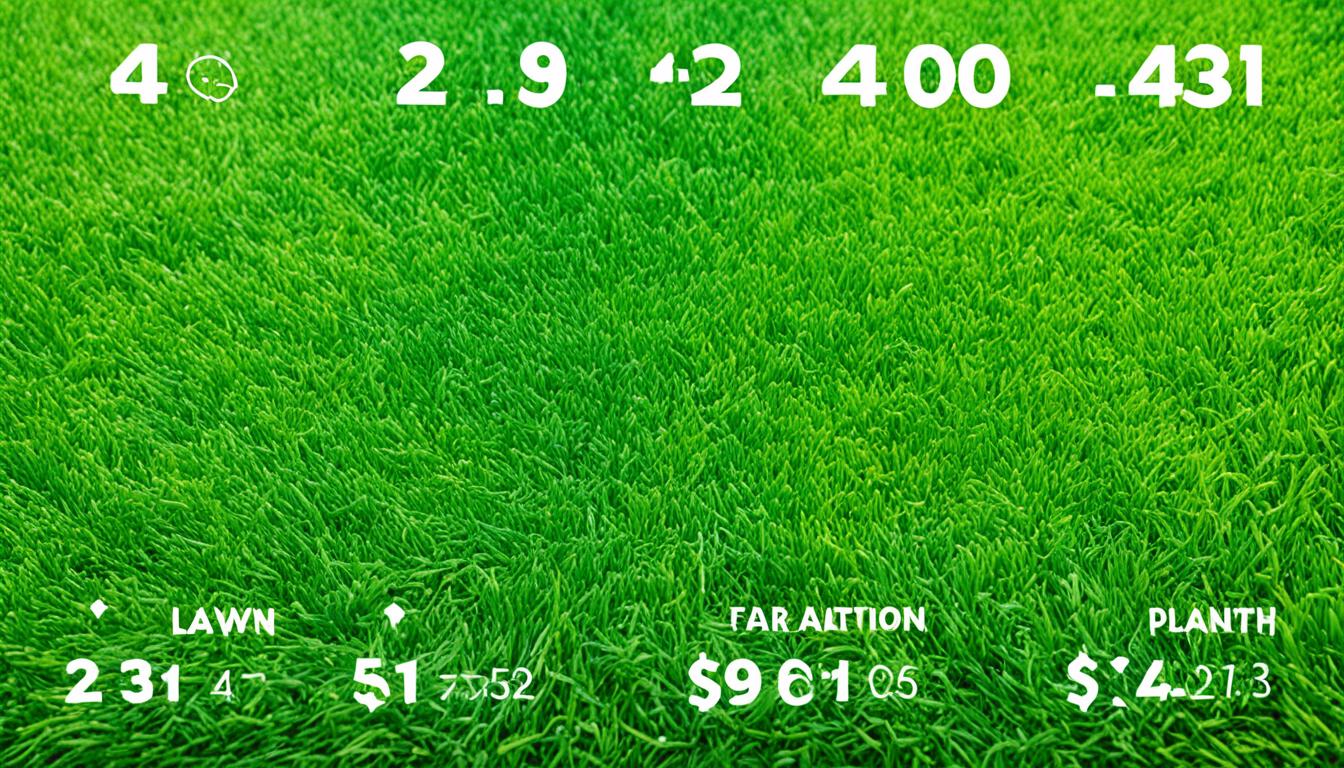When it comes to maintaining a lush and vibrant lawn, proper aeration plays a crucial role. But how much does it actually cost to aerate your lawn? Are there any factors that influence the cost? And how often should you aerate? Let’s explore these questions and more to help you make informed decisions for your lawn.
Key Takeaways:
- The average national cost for lawn aeration is around $143.
- Factors such as yard size and location can impact the cost.
- The recommended frequency for lawn aeration is at least once a year.
- Aeration promotes deeper root growth and improves the overall health of the lawn.
- You can choose between professional aerating services or DIY lawn aeration based on budget and preference.
Benefits of Lawn Aeration
Lawn aeration is a crucial practice for maintaining a healthy and vibrant lawn. The process involves creating small holes in the soil to allow for better water, oxygen, and nutrient absorption. This, in turn, offers a multitude of benefits that contribute to the overall health and appearance of your lawn.
Deeper Root Growth: By aerating your lawn, you provide an opportunity for the roots to grow deeper into the soil. This promotes stronger root systems, making your lawn more resilient and better able to withstand drought, foot traffic, and other environmental stressors.
Reduced Soil Compaction: Over time, soil can become compacted due to heavy foot traffic, equipment usage, and natural settling. Lawn aeration relieves soil compaction by creating space for the roots to spread and for essential resources like water and nutrients to penetrate deeper into the soil.
Prevention of Thatch Buildup: Thatch is a layer of organic debris that accumulates at the surface of the soil, consisting of dead roots, grass clippings, and other organic matter. Excessive thatch can prevent water, air, and nutrients from reaching the soil, negatively impacting the health of your lawn. Aeration helps reduce thatch buildup by facilitating its decomposition and promoting a healthier soil environment.
Improved Drainage: Lawns with poor drainage can suffer from waterlogging, leading to root rot and other issues. Aeration improves drainage by creating pathways for water to flow through the soil and prevent waterlogging, thereby promoting a healthier lawn.
Enhanced Fertilization and Overseeding: Aeration allows fertilizers and grass seeds to reach the soil more effectively. The holes created by aeration create optimal conditions for fertilizers to penetrate the soil and for grass seeds to establish and germinate, resulting in a thicker, lusher lawn.
Overall, the benefits of lawn aeration extend beyond the visible results. It creates a solid foundation for a healthy and thriving lawn by improving root growth, reducing soil compaction, preventing thatch buildup, improving drainage, and optimizing the effectiveness of fertilization and overseeding.
Professional Aerating Services vs. DIY Lawn Aeration
When it comes to lawn aeration, homeowners have two options: hiring professional aerating services or tackling the task themselves through DIY lawn aeration. Both approaches have their advantages and considerations, and the choice ultimately depends on factors such as budget, time availability, and personal preference.
Professional Aerating Services:
Opting for professional aerating services ensures that the job is done correctly and efficiently. Lawn care experts have the knowledge, experience, and specialized equipment needed to perform a thorough aeration. They understand the specific needs of different types of grass and can tailor the process accordingly, resulting in optimal results for lawn health and growth.
DIY Lawn Aeration:
DIY lawn aeration can be a cost-saving option, particularly for homeowners with smaller yards. It allows individuals to take control of their lawn care and save on the expenses associated with hiring professionals. However, it’s important to note that DIY lawn aeration requires physical exertion and the rental or purchase of suitable aeration equipment. It’s essential to follow proper techniques and guidelines to ensure effective aeration.
In a nutshell:
| Professional Aerating Services | DIY Lawn Aeration |
|---|---|
| Expertise and experience | Cost-saving option |
| Efficient and accurate results | Physical exertion required |
| Specialized equipment | Equipment rental or purchase |
Ultimately, the decision between professional aerating services and DIY lawn aeration depends on individual circumstances. If budget allows and time constraints are a concern, professional services may be the preferred choice. However, for those who enjoy taking a hands-on approach to lawn care and want to save on costs, DIY lawn aeration can be a rewarding and cost-effective option.

Best Time to Aerate Lawn
Aerating the lawn at the right time is crucial for optimal results. Timing plays a significant role in ensuring that the grass can recover quickly and fully benefit from the aeration process. The best time to aerate your lawn depends on the type of grass you have, whether it’s a warm-season or a cool-season grass.
For warm-season grasses like Bermudagrass, it is recommended to aerate during late spring or early summer. At this time, the grass is actively growing, and the weather conditions are favorable for its recovery. Aeration during the warmer months helps the roots penetrate deeper into the soil, resulting in a more robust and healthier lawn.
On the other hand, cool-season grasses like Kentucky bluegrass respond well to aeration when done in early spring or fall. These are the seasons when cool-season grasses experience their peak growth periods. Aeration before the summer heat or in the fall helps alleviate soil compaction, enhances nutrient absorption, and promotes vigorous root development.
By aerating your lawn during the appropriate season, you give your grass the best chance to thrive and benefit from the aeration process. This ultimately leads to a healthier, greener, and more resilient lawn that can withstand the stresses of everyday use and environmental conditions.
Lawn Aeration Equipment
When it comes to DIY lawn aeration, having the right equipment is essential for achieving optimal results. There are various types of lawn aeration equipment available, each designed to suit different soil types and conditions. Whether you’re dealing with sandy soil, loam or clay soil, or compacted soil, there’s a specific type of aerator that will address your lawn’s needs.
The two main types of lawn aeration equipment commonly used are spike aerators and core aerators. Spike aerators are ideal for sandy soil as they puncture small holes in the soil, allowing for better air circulation and moisture absorption. On the other hand, core aerators are recommended for loam or clay soil and compacted soil. These aerators remove small plugs or cores of soil, relieving compaction, and promoting better drainage.
For those who prefer to rent equipment rather than purchase, rental options for lawn aerators are widely available. Rental companies offer both spike and core aerators, allowing you to choose the equipment that suits your specific lawn’s requirements. Renting equipment can be a cost-effective solution, particularly if you don’t plan on aerating your lawn frequently or if you have a smaller yard.
It’s important to carefully consider and assess your lawn’s needs before selecting the appropriate lawn aeration equipment. Understanding the type of soil you have, its compaction level, and your lawn’s size will help you make an informed decision. By choosing the right equipment, you can ensure that your lawn receives the necessary aeration it needs to thrive.
Comparison Table: Spike Aerators vs. Core Aerators
| Aerator Type | Soil Type | Function | Benefits |
|---|---|---|---|
| Spike Aerator | Sandy soil | Punctures small holes in the soil | Improves air circulation and moisture absorption |
| Core Aerator | Loam or clay soil, compacted soil | Removes soil cores or plugs | Relieves compaction, promotes better drainage |

By using the right lawn aeration equipment, you can effectively address the specific needs of your lawn, whether it’s improving moisture absorption, relieving soil compaction, or enhancing drainage. This equipment ensures that the aeration process is carried out efficiently, providing your lawn with the necessary conditions for healthy growth and development.
Factors Affecting Lawn Aeration Cost
When considering the cost of lawn aeration, several factors come into play. These factors can impact the overall expense and should be taken into account when planning for this essential lawn care service.
Lawn Size
The size of your lawn is the most influential factor in determining the cost of lawn aeration. Larger yards require more time, effort, and resources, leading to higher costs. It is important to factor in the square footage of your lawn when budgeting for aeration services.
Preparation Work
Prior to aeration, certain preparation work needs to be done, including mowing and cleaning the lawn. These tasks can add to the overall cost of the service, as they require additional time and labor. It is essential to understand the extent of the preparation work required for your specific lawn.
Yard Slope
The slope of your yard affects the complexity of the aeration process. Lawns with steep slopes or uneven terrain may require specialized equipment or additional effort, which can increase the cost of the service. The degree of slope should be considered when evaluating the overall cost of lawn aeration.
Type of Aeration
There are various methods of lawn aeration, including spike aerators and core aerators. The type of aeration chosen can impact the cost, as each method may require different equipment or techniques. It is important to discuss the options with a professional to determine the most suitable and cost-effective approach for your lawn.
Location
The location of your property can also affect the cost of lawn aeration. Areas with higher costs of living or that are more remote may have higher prices for lawn care services. It is essential to consider regional factors when budgeting for lawn aeration.
By understanding these factors that influence the cost of lawn aeration, homeowners can make informed decisions and effectively plan for this essential maintenance service.
| Factors Affecting Lawn Aeration Cost |
|---|
| Lawn Size |
| Preparation Work |
| Yard Slope |
| Type of Aeration |
| Location |
Related Services
Optimizing the health of your lawn goes beyond just aeration. Several related services can enhance the overall condition and appearance of your lawn. By combining these services, you can ensure that your lawn remains healthy, vibrant, and beautiful throughout the year.
Mowing: Regular mowing is essential to maintain the proper height and appearance of your grass. It promotes even growth, prevents thatch accumulation, and enhances the overall aesthetic appeal of your lawn.
Overseeding: Over time, lawns can develop thin or bare patches. Overseeding involves spreading grass seeds over these areas to promote new growth and fill in any gaps, resulting in a denser, lush lawn.
Fertilization: Providing your lawn with the necessary nutrients is crucial for its health and vitality. Regular fertilization ensures that your grass receives the essential elements it needs to grow, resist disease, and maintain its green color.
Dethatching: Thatch is a layer of dead grass, roots, and other organic debris that can build up between the soil and the green vegetation. Excessive thatch accumulation can hinder water, air, and nutrient penetration. Dethatching involves removing this layer to promote a healthier soil environment for your lawn.
To make the most of these related services, many lawn care companies offer comprehensive lawn care packages that include aeration, mowing, overseeding, fertilization, and dethatching. These packages often provide discounted prices, allowing you to receive all the essential treatments your lawn needs at a more affordable cost.
| Related Services | Description |
|---|---|
| Mowing | Promotes even growth and enhances aesthetic appeal |
| Overseeding | Fills in thin or bare patches and promotes a denser lawn |
| Fertilization | Provides essential nutrients for healthy lawn growth |
| Dethatching | Removes thatch buildup for improved soil health |
Combining lawn aeration with these related services ensures a comprehensive approach to lawn care, addressing various aspects of your lawn’s health to achieve optimal results.
Cost of Aerating Your Lawn DIY
Are you considering aerating your lawn yourself? DIY lawn aeration can be a cost-effective option, but it’s essential to understand the potential costs involved. When aerating your lawn DIY, you may need to rent or purchase equipment, which adds to the overall expense.
The rental costs for lawn aerators generally range from $55 to $100 per day, depending on the type of aerator you choose. If you decide to purchase an aerator, the prices can vary significantly depending on the brand and model.
The average DIY cost for aeration can range from $53 to $170, depending on factors such as the equipment used and the size of your lawn. Keep in mind that larger lawns may require more time and effort, which can impact both the rental costs and the overall DIY expenses.
However, it’s important to note that DIY lawn aeration requires physical exertion. You’ll need to dedicate your time and energy to perform the aeration process correctly. Additionally, there is a possibility that your DIY efforts may not produce the same results as professional aeration.
If you’re confident in your abilities and enjoy tackling outdoor projects, aerating your lawn DIY can be a rewarding experience. However, if you prefer to leave the task to the experts or have a larger lawn, hiring professional aerating services may be the better option.
Conclusion
Lawn aeration is an essential practice for maintaining a healthy and lush lawn. By creating holes in the soil, aeration allows for better water, oxygen, and nutrient absorption, leading to deeper root growth and a more resilient lawn. The cost of lawn aeration can vary depending on factors such as yard size, location, and the type of aeration used.
For homeowners seeking efficient and effective results, hiring professional aerating services is recommended. Although it comes at a cost, professional services ensure that the job is done correctly and in a timely manner. On the other hand, for smaller yards, DIY lawn aeration can be a cost-saving option. DIY aeration requires physical exertion and the rental or purchase of aeration equipment but can be a satisfying and rewarding task for some homeowners.
Regardless of the approach chosen, lawn aeration should be performed at the appropriate time. Warm-season grasses like Bermudagrass should be aerated in late spring or early summer, while cool-season grasses like Kentucky bluegrass benefit from aeration in early spring or fall. It is also important to combine aeration with other necessary lawn treatments, such as mowing, overseeding, fertilization, and dethatching, to ensure optimal results and promote overall lawn health.





